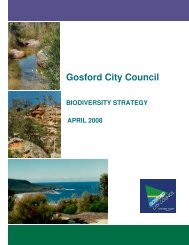Gosford City Council Historical Water Quality Review & Analysis
Gosford City Council Historical Water Quality Review & Analysis
Gosford City Council Historical Water Quality Review & Analysis
You also want an ePaper? Increase the reach of your titles
YUMPU automatically turns print PDFs into web optimized ePapers that Google loves.
RESULTS OF WATER QUALITY DATA ANALYSIS 3-13<br />
3.1.3 Compound <strong>Water</strong> <strong>Quality</strong> Index<br />
Considerable insight to the water quality of the <strong>Gosford</strong> waterways can be obtained through<br />
investigation of the various water quality parameters, as discussed in the preceding Sections of this<br />
report. However, it is most useful to simplify the information into a single parameter, which can be<br />
reported to the community and <strong>Council</strong>lors to give an overall indication of the general water quality<br />
condition.<br />
In order to obtain a ‘Compound <strong>Water</strong> <strong>Quality</strong> Index’, the data from a range of water quality<br />
parameters needs to be synthesised and considered concurrently. For each major water quality<br />
parameter, the measured concentration is compared to a criteria set, and categorised into one of four<br />
different ranges. The overall water quality score can be determined by applying a value to each of the<br />
ranges (1 = good; 4 = highly degraded), summing the individual scores, and then dividing by the<br />
number of parameters included in the assessment.<br />
Table 3.22 presents the key water quality parameters and the interim relative ranges (and scores) for<br />
each as applicable to the <strong>Gosford</strong> waterways. Although Chlorophyll-a was not included in the most<br />
recent water quality monitoring program (as described in the previous Sections of this report), it has<br />
been included in the matrix below for future reference, as it is an extremely valuable water quality<br />
indicator that is likely to be included as part of any future monitoring program.<br />
Table 3.22 <strong>Gosford</strong> <strong>Water</strong> <strong>Quality</strong> Index Range Definition Matrix<br />
Parameter Range 1<br />
(value = 1)<br />
Range 2<br />
(value = 2)<br />
Range 3<br />
(value = 3)<br />
Range 4<br />
(value = 4)<br />
Turbidity 0 – 5 NTU 5 – 15 NTU 15 – 30 NTU > 30 NTU<br />
Dissolved Oxygen > 6.5 mg/L 4.0 – 6.5 mg/L 2.0 – 4.0 mg/L < 2.0 mg/L<br />
Ammonia 0 – 0.01 mg/L 0.01 – 0.03 mg/L 0.03 – 0.05 mg/L > 0.05 mg/L<br />
Oxidised Nitrogen 0 – 0.02 mg/L 0.02 – 0.05 mg/L 0.05 – 0.10 mg/L > 0.10 mg/L<br />
Total Nitrogen 0 – 1.0 mg/L 1.0 – 1.5 mg/L 1.5 – 2.0 mg/L > 2.0 mg/L<br />
Orthophosphate 0 –0.01 mg/L 0.01 – 0.03 mg/L 0.03 – 0.05 mg/L > 0.05 mg/L<br />
Total Phosphorus 0 – 0.05 mg/L 0.05 – 0.10 mg/L 0.10 – 0.20 mg/L > 0.20 mg/L<br />
Chlorophyll-a 0 – 2 µg/L 2 – 5 µg/L 5 – 10 µg/L > 10 µg/L<br />
<strong>Water</strong>ways that exhibit water quality concentrations within Range 1 can be considered to be in<br />
relatively good condition (with respect to water quality at least). If waterways start to exhibit a large<br />
number of Range 3 or Range 4 values, then it would tend to indicate a more degraded system (which<br />
is likely to have follow-on effects to the general aquatic ecosystem). The values provided in Table<br />
3.22 are intended to provide a more sites-specific assessment of water quality, as recommended by<br />
ANZECC (2000). In determining the values, consideration was given to the default trigger values for<br />
physical and chemical stressors (as defined in ANZECC, 2000), along with an appreciation of the<br />
historical water quality results.<br />
D:\R.N0754.002.01.DOC 7/11/03 16:11
















